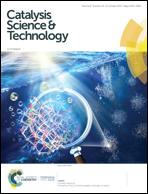Microwave synthesis of ZnIn2S4/WS2 composites for photocatalytic hydrogen production and hexavalent chromium reduction†
Abstract
A rapid microwave synthesis route for the fabrication of ZnIn2S4 powder and ZnIn2S4/WS2 composites is presented. Firstly, the effects of different sulfur sources – thioacetamide and L-cysteine – on the physicochemical properties and photocatalytic H2 production of the synthesized ZnIn2S4 were investigated. It was found that well-defined flower-like ZnIn2S4 microspheres obtained from L-cysteine facilitated a relatively higher H2 production rate. Then, different loadings of WS2 were introduced into the well-defined flower-like ZnIn2S4 microspheres aiming to improve its photocatalytic H2 production. Compared to pure ZnIn2S4 and WS2, all ZnIn2S4/WS2 composite photocatalysts exhibited enhanced photocatalytic H2 production in the presence of Na2S/Na2SO3 as sacrificial reagents under UV-visible irradiation, where the ZnIn2S4/WS2-40% wt composite had the highest photocatalytic activity. For this material, 293.3 and 76.6 μmol h−1 g−1 of H2 gas were produced under UV-visible and visible light irradiation, respectively. In addition, the photoreduction activity of hexavalent chromium (Cr(VI)) by ZnIn2S4/WS2-40% wt was also investigated under visible light irradiation and it was observed that 98.5% of Cr(VI) was reduced within 90 min at pH 4.



 Please wait while we load your content...
Please wait while we load your content...